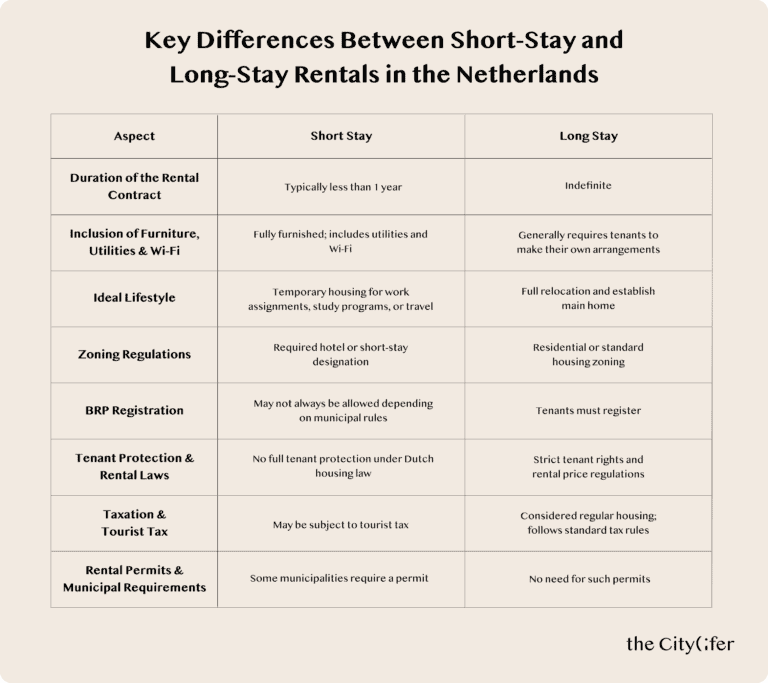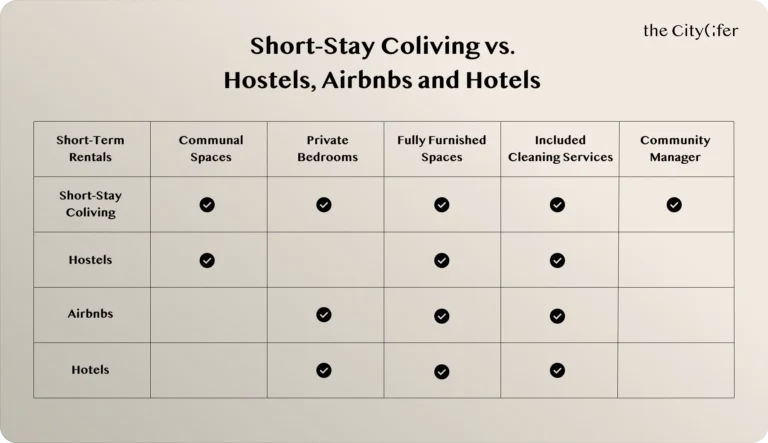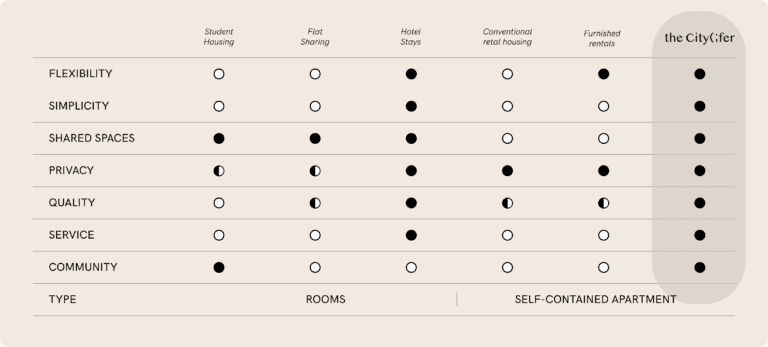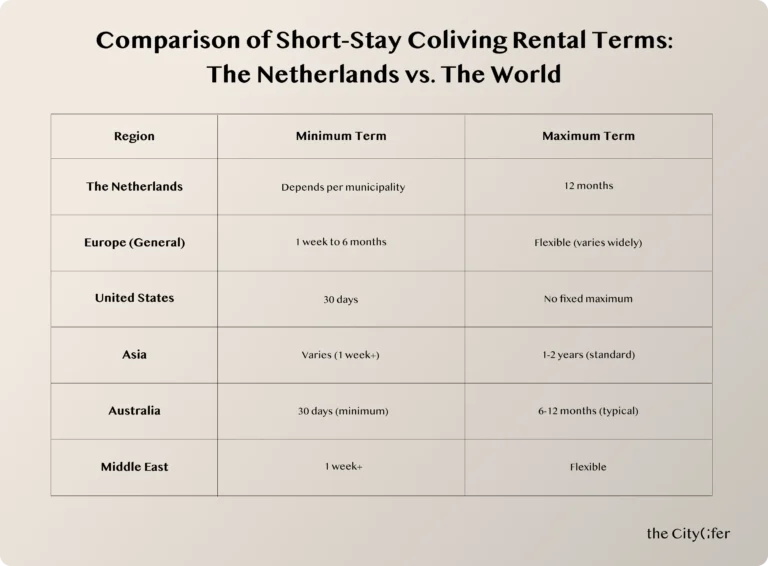With skyrocketing housing prices and an increasing demand for flexibility and high service, short-stay coliving is emerging as a solution for modern nomads, remote workers, and students alike. But what makes it so appealing, and why is it shaping the future of housing?
In this guide, we share all the benefits, key features, and essential tips for those looking for flexible, community-driven living arrangements like short-stay coliving. We will also explore various types of short-term rentals and learn the difference between short-stay coliving and staying in hotels, hostels, and Airbnbs.

What Is Short-Stay Coliving and Why Is It Growing?
Short-term rentals are self-contained apartments or homes that people rent for a short time. Its most common examples are those available properties on Airbnb, providing another accommodation option apart from hotels.
Short-stays are rental arrangements that can last within a within a few days, weeks, months, up to a year. These durations differ across the world, providing you more options to choose from! It’s a lot like traditional apartment living, minus the long-term lease contract.
In the Netherlands, you’ll be glad to know that short-stays are always fully furnished for your convenience. This is, after all, one of the main requirements for this arrangement in the country. And if you’re seeking a type of short stay that allows you to enjoy both comfortable accommodation and communal spaces, you’re in luck as there are coliving spaces that offer just that.
Because of this, short-stay coliving provides a sense of flexibility and community for everyday living.

Short Stay vs. Long Stay
The difference between the two is pretty obvious, but let’s get into more detail. In the Netherlands, the government differentiates between short-stay and long-stay based on several factors. Here are the key distinctions:
- Duration of the Rental Contract – Short-stay is typically less than one year, while long-stay applies to indefinite or long-term rentals.
- Inclusion of Furniture, Utilities, and Wi-Fi – Short-stay accommodations must be fully furnished and include utilities and Wi-Fi as part of the rental price. Long-stay rentals generally require tenants to arrange these themselves.
- Your primary residence – Short-stay is meant for temporary residence, such as for work assignments, study programs, or travel. They also need to have a primary residence to return to, elsewhere. Long-stay applies when someone fully relocates and establishes their primary residence.
- Zoning Regulations – Short-stay rentals typically require a hotel or short-stay designation in the municipal zoning plan. Residential rentals fall under standard housing zoning.
- BRP Registration (Personal Records Database) – Short-stay renters may not always be allowed to register at the address in the BRP, depending on municipal rules. Long-stay tenants must register.
- Tenant Protection & Rental Laws – Short-stay rentals do not provide full tenant protection under Dutch housing law, while long-stay rentals are subject to strict tenant rights and rental price regulations.
- Taxation & Tourist Tax – Short-stay properties may be subject to tourist tax, similar to hotels, whereas long-stay rentals are considered regular housing and follow standard tax rules.
- Rental Permits & Municipal Requirements – Some municipalities require a permit for short-stay rentals, while long-term residential leases do not need such permits.

Types of Short Term Rentals
What’s the difference between Hostels, Airbnbs, Hotels, and Short-Stay Coliving?

Hostels and hotels are primarily designed for leisure stays—people don’t truly “live” there, even temporarily.
Then, there are hybrid options like Airbnb, serviced apartments, and short-stay coliving. These cater to travelers, remote workers, and those on temporary assignments. While people stay for weeks or months, their “center of life” remains elsewhere—they don’t intend to settle in that city permanently.
Hotels and short-stay coliving spaces differ significantly. While hotels have communal areas (such as a lobby, swimming pool, bar, etc.), they vary in room types, amenities, and typical length of stay. Hotels cater to short-term guests with private, service-focused hotel rooms, while coliving spaces are designed for longer stays, offering fully furnished apartments, fostering community and shared experiences.
The same difference applies to hostels. These spaces offer budget-friendly accommodations for short-term travelers seeking a social atmosphere. However, they don’t foster a true sense of community since guests typically stay only a few nights.
In contrast, short-stay coliving is designed for longer stays—generally ranging from one month to a year—creating a more stable environment for building connections and a shared lifestyle.
Finally, residential options such as long-stay coliving and family apartments are for those who fully relocate. These individuals aren’t just passing through; they establish their lives in the city and have no plans to leave after a few months.
Each type of stay—leisure, short-stay, and long-stay—serves a distinct audience with different needs and expectations.
In the Netherlands, there are three types of stays: Lodging, Short-Stay, and Long-Stay (Residential).
Lodging
Hotel
- Length of Stay: Typically 7 to 28 days, with some extended-stay options.
- Zoning Requirements: Requires a hotel/logies designation in the zoning plan.
- Rules & Restrictions:
- No tenant protection for guests.
- Guests cannot register at the address in the Dutch Personal Records Database (BRP).
- Fully furnished private rooms, often with hotel amenities (e.g., housekeeping, restaurants, gyms).
- Not intended for long-term residence.
Hostel
- Length of Stay: Typically 1 night to a few weeks, depending on availability.
- Zoning Requirements: Requires a lodging designation, similar to hotels.
- Rules & Restrictions:
- No tenant protection for guests.
- Guests cannot register in the BRP.
- Usually dormitory-style accommodation (bunk beds in shared rooms), though some hostels offer private rooms.

Short-Stay
Airbnb (Short-Term Rentals)
- Length of Stay: Varies from a few nights to several months, depending on listing type and local laws.
- Zoning Requirements: Some municipalities restrict Airbnb rentals, requiring permits or specific designations.
- Rules & Restrictions:
- No tenant protection, unless the stay exceeds a specific period.
- BRP registration is generally not allowed unless permitted by local rules.
- No standardized communal spaces, as listings range from private rooms to entire homes.
- Managed by individual hosts, with limited on-site services.
- Additional cleaning fees and variable pricing.
Short-Stay Coliving
- Length of Stay: Typically 1 to 9 months, with a maximum of 1 year (varies by municipality).
- Zoning Requirements: Requires a short-stay or hotel designation in the zoning plan.
- Rules & Restrictions:
- Not intended for permanent residence.
- Some municipalities require a permit for short-stay coliving operations.
- No standard tenant protection, unless the lease is incorrectly structured or the stay exceeds the permitted period.
- BRP registration may be allowed in some cases.
- Offers private apartments with shared communal spaces (kitchens, coworking areas).
- Often managed by community managers, providing social events and cleaning services.

Serviced Apartments
- Length of Stay: Usually a few weeks to several months, depending on contract terms.
- Zoning Requirements: Can be classified as short-stay or commercial housing, depending on the municipality.
- Rules & Restrictions:
- No tenant protection, as serviced apartments operate under hospitality regulations.
- BRP registration depends on the contract—some allow it, others do not.
- Fully furnished, with hotel-like services (cleaning, reception, utilities included).
- Higher pricing compared to coliving, as they cater to business travelers and expats.
Residential (Long-Term Housing)
- Length of Stay: Indefinite or longer than 1 year (the standard minimum for residential rental contracts).
- Zoning Requirements: Requires a residential designation in the zoning plan.
- Rules & Restrictions:
- Full tenant protection under Dutch tenancy laws.
- Tenants must register at the address in the BRP.
- Rental price regulations apply to social housing and, in some cases, private sector rentals.
- Landlords must comply with the Dutch Civil Code and rental laws.
Who Is Short-Stay Coliving For?
People who seek convenience and versatility benefit the most from short-stay coliving. Digital nomads, travelers, and remote workers are the most common target audiences for this lifestyle. Students and those temporarily relocating are also perfect for this arrangement. Apartment renters wanting proper housing minus the long-term commitment will also love short-term coliving.

Lease Terms You Should Know About
Lease terms for short stay arrangements allow tenants to go for weekly or monthly arrangements. Some properties also offer the option to adjust the duration of your stay according to your needs.
Because of this arrangement, you can easily navigate the duration of their accommodation minus the strict, more fixed terms of traditional leases.
Weekly vs. Monthly Lease Options
Weekly Lease
- Typically used for very short-term accommodations.
- Higher cost per day compared to monthly leases.
- Often includes utilities and services.
Monthly Lease
- Suitable for medium-to-long-term stays.
- Generally more cost-effective on a per-day basis.
- Utilities may or may not be included; clarify with the landlord.
- In the Netherlands, short-stay rentals must include fully furnished apartments with utilities and WiFi.
- If tenants are required to arrange these themselves, the rental is considered long-term housing. This grants them extensive tenant protection rights and legal safeguards.
Rental Contracts in the Netherlands and their Cancellation Policies
In the Dutch residential market, there are only two types of rental contracts to choose from:
Temporary contract with a fixed end date – This type of tenancy can be terminated by tenants with a notice period. The landlord can only terminate the contract at the agreed end date. If neither party cancels, the contract automatically converts into an indefinite contract.
Indefinite contract without a set end date – After the initial fixed period (e.g., 12 months), the tenant can terminate the lease with a typical notice period of one month. However, the landlord cannot unilaterally terminate an indefinite contract, even after the initial fixed period.

However, temporary rental contracts will only be allowed in specific cases, such as:
- You are a student renting temporarily in a different municipality than where you normally reside for your studies.
- You must temporarily relocate due to renovation or construction work on your current home.
- You are going through a divorce, can prove that you no longer live with your partner, and need a temporary home to stay close to your child(ren).
Flexibility for Extensions or Custom Agreements for Short Stay in the Netherlands
Flexibility plays yet another key role in short-stay rentals, and this time in extensions and customized agreements. The maximum duration of short stays differs per city, but it’s never beyond 12 months. Just remember to discuss these extension terms before your initial lease expires.
If you’re seeking a customized agreement with your landlord, that is also possible with short-term coliving. Landlords provide this especially for expats and temporary workers.
Minimum and Maximum Rental Lease Periods for Short-Term Rentals
In The Netherlands
Every city has its own specific rules on minimum and maximum stays, which mostly overlap but can differ slightly. The maximum lease is generally 4, 6, 9, or 12 months, while minimum stays can be as short as one night or a few weeks.
In most municipalities, the “Regulation on Access to the Housing Market and Composition of the Housing Stock“ (Verordening toegang woningmarkt en samenstelling woningvoorraad) is in place. This type of regulation outlines what is allowed in short-stay rentals, tourist accommodations, rental policies, and other housing-related rules.
Navigating these regulations is pretty complex, so we’re here to help you out. If your company needs guidance on compliance, short-stay policies, or rental regulations, we’re ready to assist you with our consultancy services. Learn more here!
In The Rest of the World
Rental lease terms vary widely across countries based on housing regulations, market norms, and landlord-tenant agreements.
Read the visual below for a quick overview!

Europe
- United Kingdom: Minimum term of six months is common for Assured Shorthold Tenancies (AST). No maximum term is legislated, though agreements longer than three years often require notarization.
- Germany: No legal minimum; rental contracts can be as short as days for sublets. Long-term rentals (over 12 months) dominate the market.
- France: Vacation rentals often have a one-week minimum. Residential leases typically require one-year minimum, with automatic renewal.

United States
- Short-Term Rentals: Often regulated by state or city laws. A common minimum is 30 days, especially in cities with anti-Airbnb laws (e.g., New York City, San Francisco).
- Maximum Term: Generally flexible, but leases longer than 99 years may trigger special legal considerations in some states.

Asia
- Japan: Short-term stays are typically capped at 30 days without special licenses. Standard leases are two years, renewable.
- Singapore: Minimum rental period for private homes is three months (or six months for Housing Development Board flats)

Australia
- Minimum: Typically 30 days, but shorter stays (1-7 days) are common for holiday rentals.
- Maximum: Residential leases typically run for 6-12 months, with renewals negotiable.

Middle East
- UAE (Dubai): Short-term leases can be as brief as one week for vacation rentals, with no hard limit on maximum duration.
- Saudi Arabia: Rentals are typically structured month-to-month, with longer leases negotiated case-by-case.

Conclusion
Short-stay coliving is the best of both worlds. It provides the flexibility and hassle-free experience of short-term rentals, and the vibrant community aspect of coliving.
While short-term accommodations such as Airbnbs and hotels also provide complete comfort and privacy, not all of them have communal spaces that foster a sense of community. Hostels commonly have communal spaces, but they tend to offer dormitory-style lodging, which isn’t ideal for those who seek their own private rooms.
Fortunately, coliving continues to evolve and adjust to today’s society and lifestyle needs. Short-stay coliving isn’t just a living solution—it’s a lifestyle that bridges the gap between community and independence.
This type of lifestyle offers convenience, affordability, and a meaningful social experience. Forget impersonal accommodations and chaotic shared rooms. Imagine a space where you can thrive, connect, and create—welcome to the world of short-stay coliving!
FAQ
Short stay coliving is a type of short term rental that provides communal spaces for a flexible, convenient and community driven lifestyle.
Short stay coliving properties are different from each other so they have different price points. But they are generally more expensive than traditional housing as they have greater flexibility, higher service levels, and better quality of offerings. Additionally, the government currently charges 9% (soon increasing to 21%) VAT on short-stay accommodations, whereas long-stay housing is exempt from VAT. This tax difference also contributes to the higher price. But through the coliving aspect of short stay coliving, people can split utility costs like energy and internet, ensuring lower expenses.
Short stay coliving provides all inclusive pricing for your convenience. Coliving costs include the rent, as well as energy, water, home appliances, WiFi and cleaning services, which they provide already.
The minimum and maximum days of stay varies depending on the location and the property itself. In the Netherlands, there is no strict minimum lease in the law, but many municipalities regulate short stays that last less than 28 days through permits and restrictions. Meanwhile the maximum stay period in the country for short stays are typically around four months to one year.





